Earthquake Engineering Applications: A Post Graduate Research Report
VerifiedAdded on 2023/06/11
|11
|2048
|290
Report
AI Summary
This research report provides an overview of earthquake engineering, focusing on its applications and impact on mitigating the effects of seismic events. The methodology includes questionnaires, direct observations, literature reviews, and expert interviews to gather data on earthquake experiences, damage levels, and preparedness. The results highlight the use of earthquake-resistant structures, seismic retrofitting techniques, and technologies to minimize deformations and prevent structural collapses due to soft story effects and soil liquefaction. The report also discusses the use of timber framing, reinforced concrete, prestressed structures, dampers, and steel structures in earthquake engineering, emphasizing the importance of pre-qualifying cyclic tests for steel ductility. It concludes by advocating for hybrid solutions combining field observations and analytical examinations to improve the accuracy of seismic performance assessments and emphasizes the role of collaboration and data sharing in developing effective disaster mitigation strategies. Desklib provides access to this and other solved assignments for students.
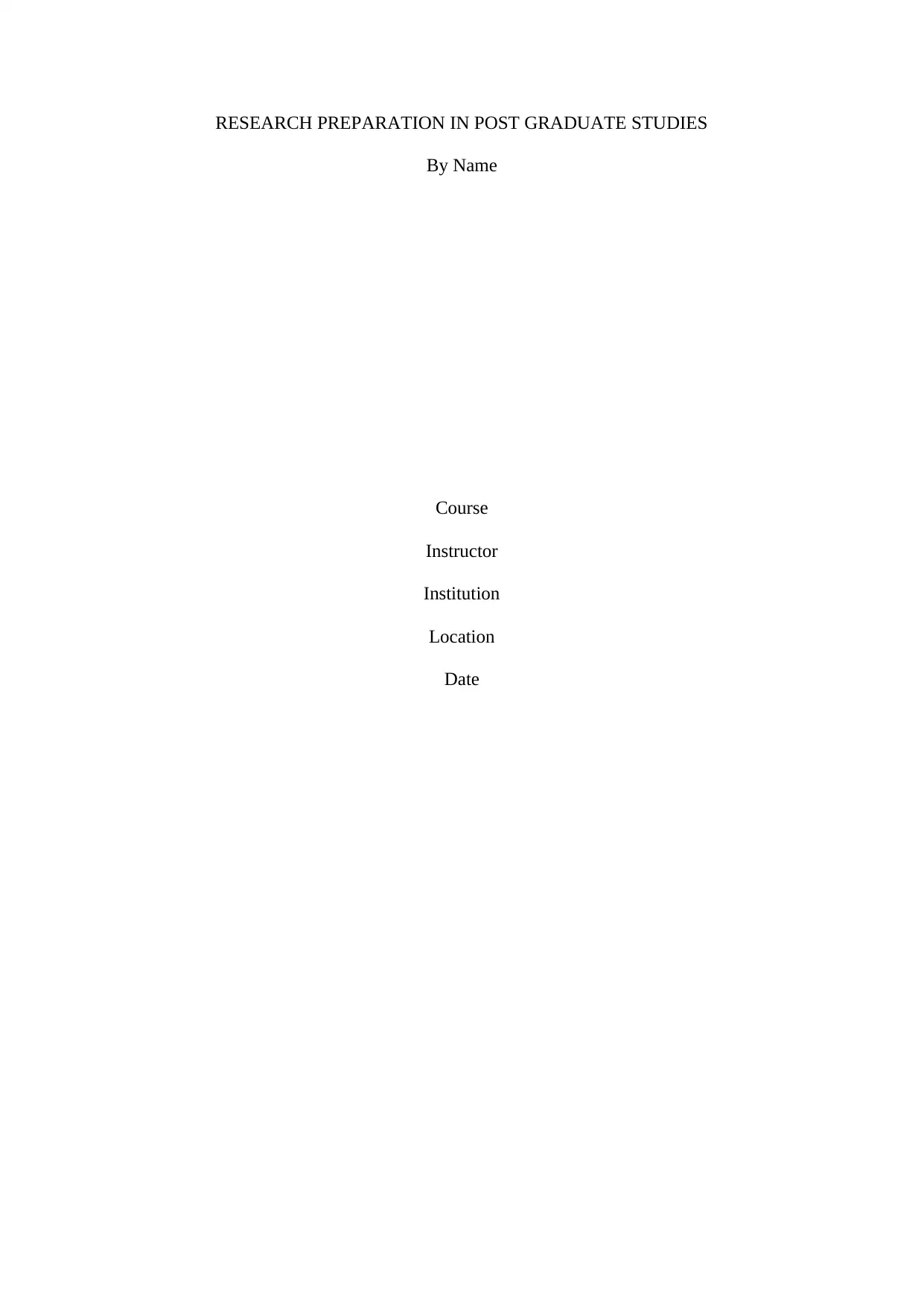
RESEARCH PREPARATION IN POST GRADUATE STUDIES
By Name
Course
Instructor
Institution
Location
Date
By Name
Course
Instructor
Institution
Location
Date
Paraphrase This Document
Need a fresh take? Get an instant paraphrase of this document with our AI Paraphraser
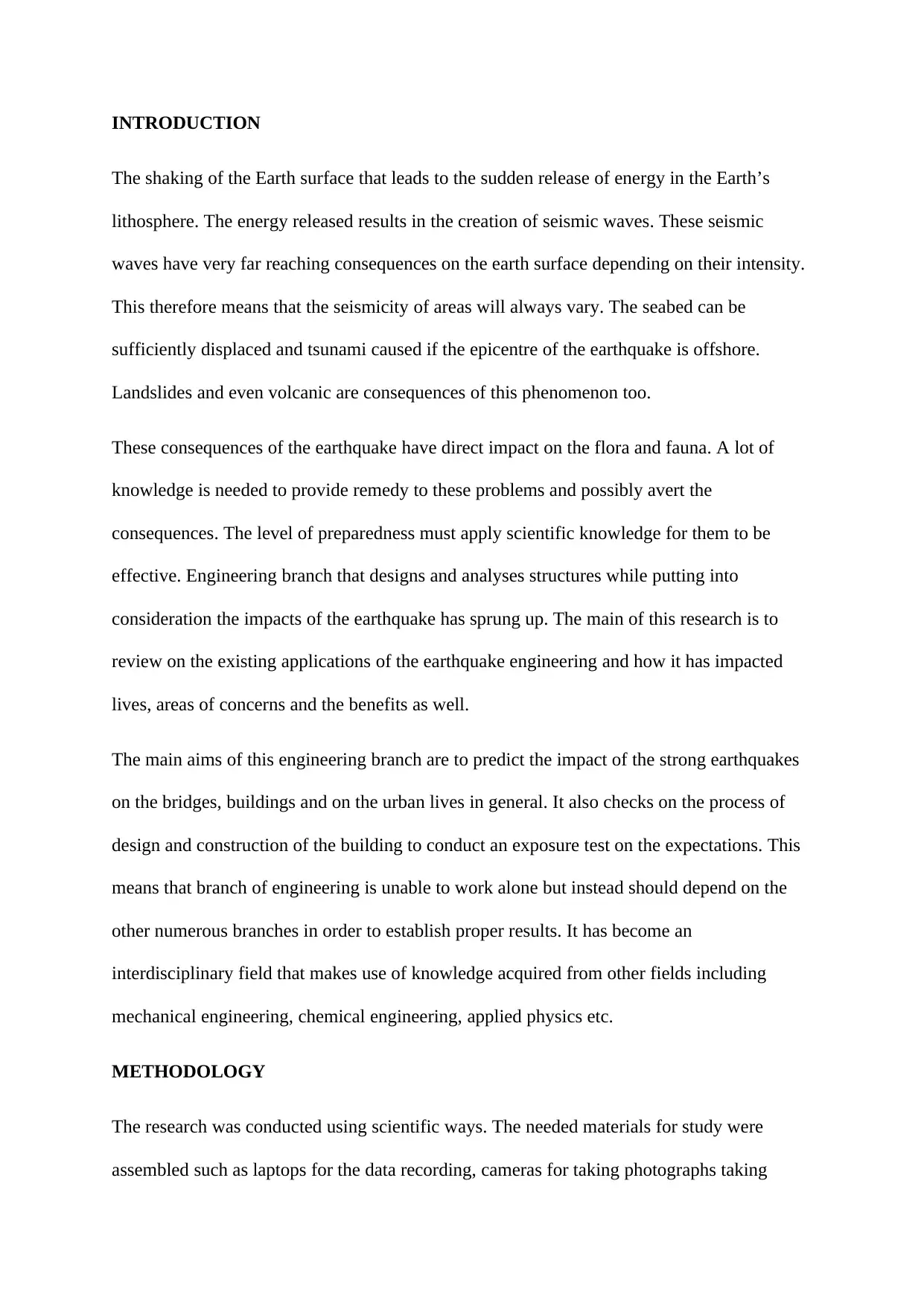
INTRODUCTION
The shaking of the Earth surface that leads to the sudden release of energy in the Earth’s
lithosphere. The energy released results in the creation of seismic waves. These seismic
waves have very far reaching consequences on the earth surface depending on their intensity.
This therefore means that the seismicity of areas will always vary. The seabed can be
sufficiently displaced and tsunami caused if the epicentre of the earthquake is offshore.
Landslides and even volcanic are consequences of this phenomenon too.
These consequences of the earthquake have direct impact on the flora and fauna. A lot of
knowledge is needed to provide remedy to these problems and possibly avert the
consequences. The level of preparedness must apply scientific knowledge for them to be
effective. Engineering branch that designs and analyses structures while putting into
consideration the impacts of the earthquake has sprung up. The main of this research is to
review on the existing applications of the earthquake engineering and how it has impacted
lives, areas of concerns and the benefits as well.
The main aims of this engineering branch are to predict the impact of the strong earthquakes
on the bridges, buildings and on the urban lives in general. It also checks on the process of
design and construction of the building to conduct an exposure test on the expectations. This
means that branch of engineering is unable to work alone but instead should depend on the
other numerous branches in order to establish proper results. It has become an
interdisciplinary field that makes use of knowledge acquired from other fields including
mechanical engineering, chemical engineering, applied physics etc.
METHODOLOGY
The research was conducted using scientific ways. The needed materials for study were
assembled such as laptops for the data recording, cameras for taking photographs taking
The shaking of the Earth surface that leads to the sudden release of energy in the Earth’s
lithosphere. The energy released results in the creation of seismic waves. These seismic
waves have very far reaching consequences on the earth surface depending on their intensity.
This therefore means that the seismicity of areas will always vary. The seabed can be
sufficiently displaced and tsunami caused if the epicentre of the earthquake is offshore.
Landslides and even volcanic are consequences of this phenomenon too.
These consequences of the earthquake have direct impact on the flora and fauna. A lot of
knowledge is needed to provide remedy to these problems and possibly avert the
consequences. The level of preparedness must apply scientific knowledge for them to be
effective. Engineering branch that designs and analyses structures while putting into
consideration the impacts of the earthquake has sprung up. The main of this research is to
review on the existing applications of the earthquake engineering and how it has impacted
lives, areas of concerns and the benefits as well.
The main aims of this engineering branch are to predict the impact of the strong earthquakes
on the bridges, buildings and on the urban lives in general. It also checks on the process of
design and construction of the building to conduct an exposure test on the expectations. This
means that branch of engineering is unable to work alone but instead should depend on the
other numerous branches in order to establish proper results. It has become an
interdisciplinary field that makes use of knowledge acquired from other fields including
mechanical engineering, chemical engineering, applied physics etc.
METHODOLOGY
The research was conducted using scientific ways. The needed materials for study were
assembled such as laptops for the data recording, cameras for taking photographs taking
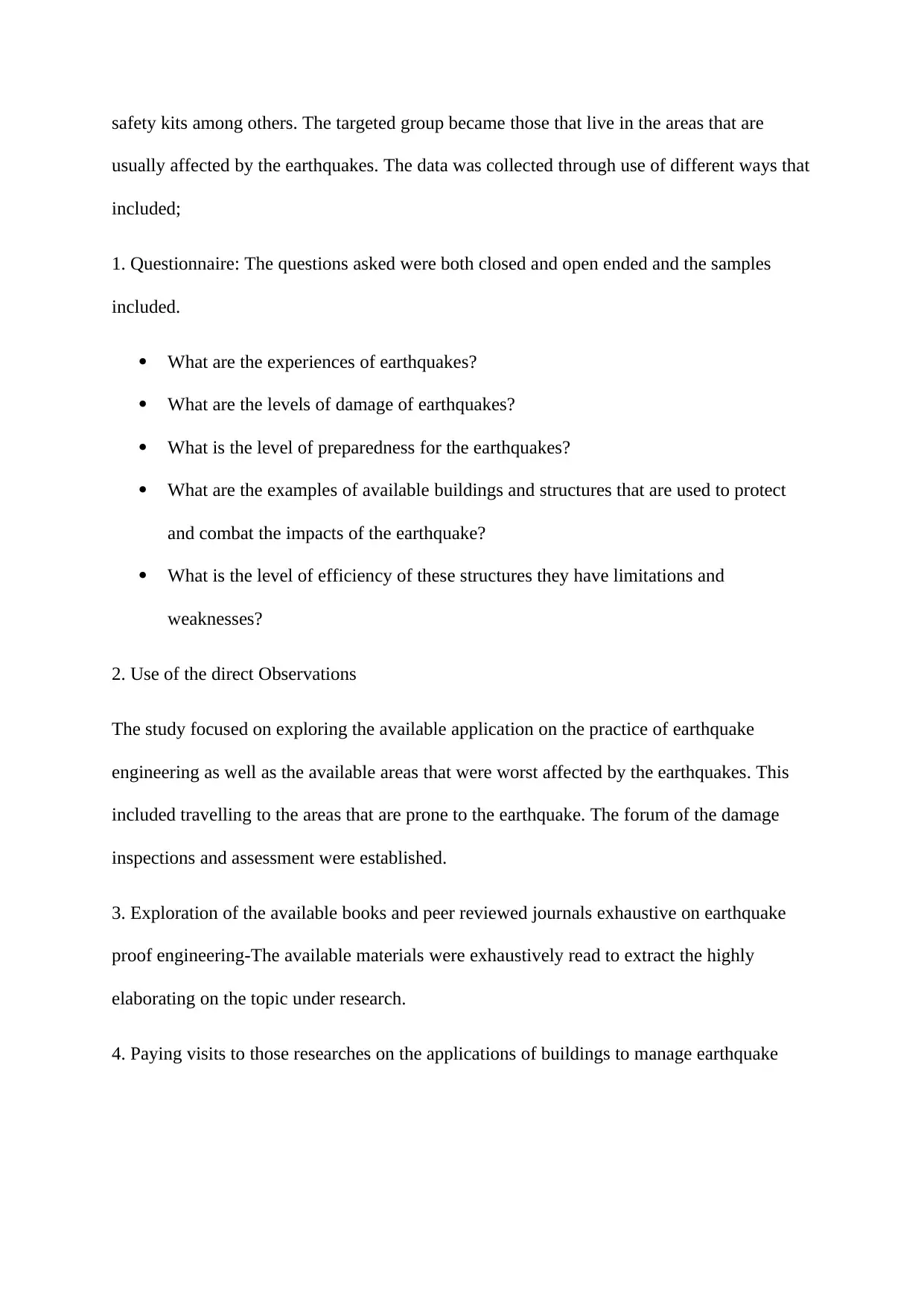
safety kits among others. The targeted group became those that live in the areas that are
usually affected by the earthquakes. The data was collected through use of different ways that
included;
1. Questionnaire: The questions asked were both closed and open ended and the samples
included.
What are the experiences of earthquakes?
What are the levels of damage of earthquakes?
What is the level of preparedness for the earthquakes?
What are the examples of available buildings and structures that are used to protect
and combat the impacts of the earthquake?
What is the level of efficiency of these structures they have limitations and
weaknesses?
2. Use of the direct Observations
The study focused on exploring the available application on the practice of earthquake
engineering as well as the available areas that were worst affected by the earthquakes. This
included travelling to the areas that are prone to the earthquake. The forum of the damage
inspections and assessment were established.
3. Exploration of the available books and peer reviewed journals exhaustive on earthquake
proof engineering-The available materials were exhaustively read to extract the highly
elaborating on the topic under research.
4. Paying visits to those researches on the applications of buildings to manage earthquake
usually affected by the earthquakes. The data was collected through use of different ways that
included;
1. Questionnaire: The questions asked were both closed and open ended and the samples
included.
What are the experiences of earthquakes?
What are the levels of damage of earthquakes?
What is the level of preparedness for the earthquakes?
What are the examples of available buildings and structures that are used to protect
and combat the impacts of the earthquake?
What is the level of efficiency of these structures they have limitations and
weaknesses?
2. Use of the direct Observations
The study focused on exploring the available application on the practice of earthquake
engineering as well as the available areas that were worst affected by the earthquakes. This
included travelling to the areas that are prone to the earthquake. The forum of the damage
inspections and assessment were established.
3. Exploration of the available books and peer reviewed journals exhaustive on earthquake
proof engineering-The available materials were exhaustively read to extract the highly
elaborating on the topic under research.
4. Paying visits to those researches on the applications of buildings to manage earthquake
⊘ This is a preview!⊘
Do you want full access?
Subscribe today to unlock all pages.

Trusted by 1+ million students worldwide
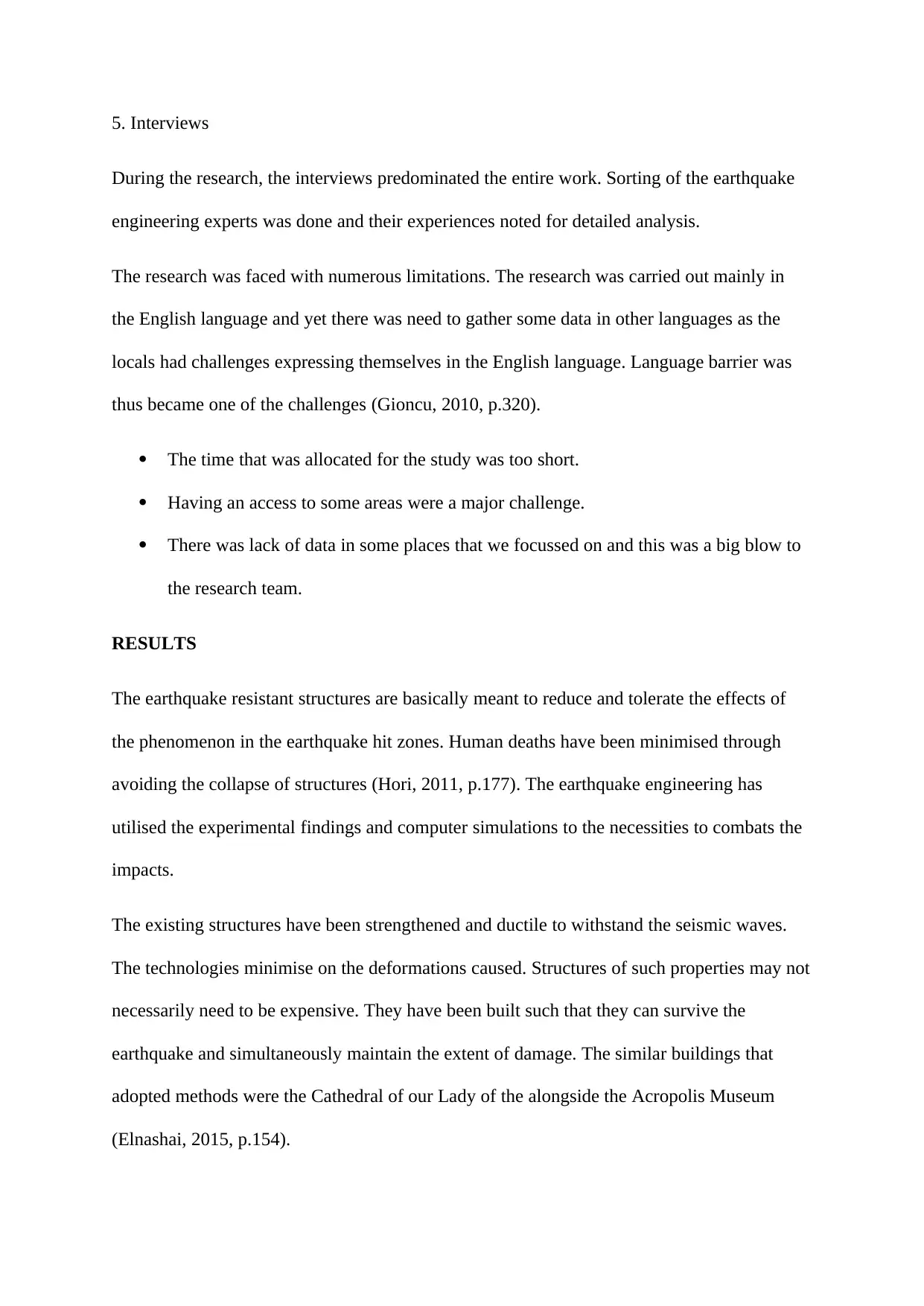
5. Interviews
During the research, the interviews predominated the entire work. Sorting of the earthquake
engineering experts was done and their experiences noted for detailed analysis.
The research was faced with numerous limitations. The research was carried out mainly in
the English language and yet there was need to gather some data in other languages as the
locals had challenges expressing themselves in the English language. Language barrier was
thus became one of the challenges (Gioncu, 2010, p.320).
The time that was allocated for the study was too short.
Having an access to some areas were a major challenge.
There was lack of data in some places that we focussed on and this was a big blow to
the research team.
RESULTS
The earthquake resistant structures are basically meant to reduce and tolerate the effects of
the phenomenon in the earthquake hit zones. Human deaths have been minimised through
avoiding the collapse of structures (Hori, 2011, p.177). The earthquake engineering has
utilised the experimental findings and computer simulations to the necessities to combats the
impacts.
The existing structures have been strengthened and ductile to withstand the seismic waves.
The technologies minimise on the deformations caused. Structures of such properties may not
necessarily need to be expensive. They have been built such that they can survive the
earthquake and simultaneously maintain the extent of damage. The similar buildings that
adopted methods were the Cathedral of our Lady of the alongside the Acropolis Museum
(Elnashai, 2015, p.154).
During the research, the interviews predominated the entire work. Sorting of the earthquake
engineering experts was done and their experiences noted for detailed analysis.
The research was faced with numerous limitations. The research was carried out mainly in
the English language and yet there was need to gather some data in other languages as the
locals had challenges expressing themselves in the English language. Language barrier was
thus became one of the challenges (Gioncu, 2010, p.320).
The time that was allocated for the study was too short.
Having an access to some areas were a major challenge.
There was lack of data in some places that we focussed on and this was a big blow to
the research team.
RESULTS
The earthquake resistant structures are basically meant to reduce and tolerate the effects of
the phenomenon in the earthquake hit zones. Human deaths have been minimised through
avoiding the collapse of structures (Hori, 2011, p.177). The earthquake engineering has
utilised the experimental findings and computer simulations to the necessities to combats the
impacts.
The existing structures have been strengthened and ductile to withstand the seismic waves.
The technologies minimise on the deformations caused. Structures of such properties may not
necessarily need to be expensive. They have been built such that they can survive the
earthquake and simultaneously maintain the extent of damage. The similar buildings that
adopted methods were the Cathedral of our Lady of the alongside the Acropolis Museum
(Elnashai, 2015, p.154).
Paraphrase This Document
Need a fresh take? Get an instant paraphrase of this document with our AI Paraphraser
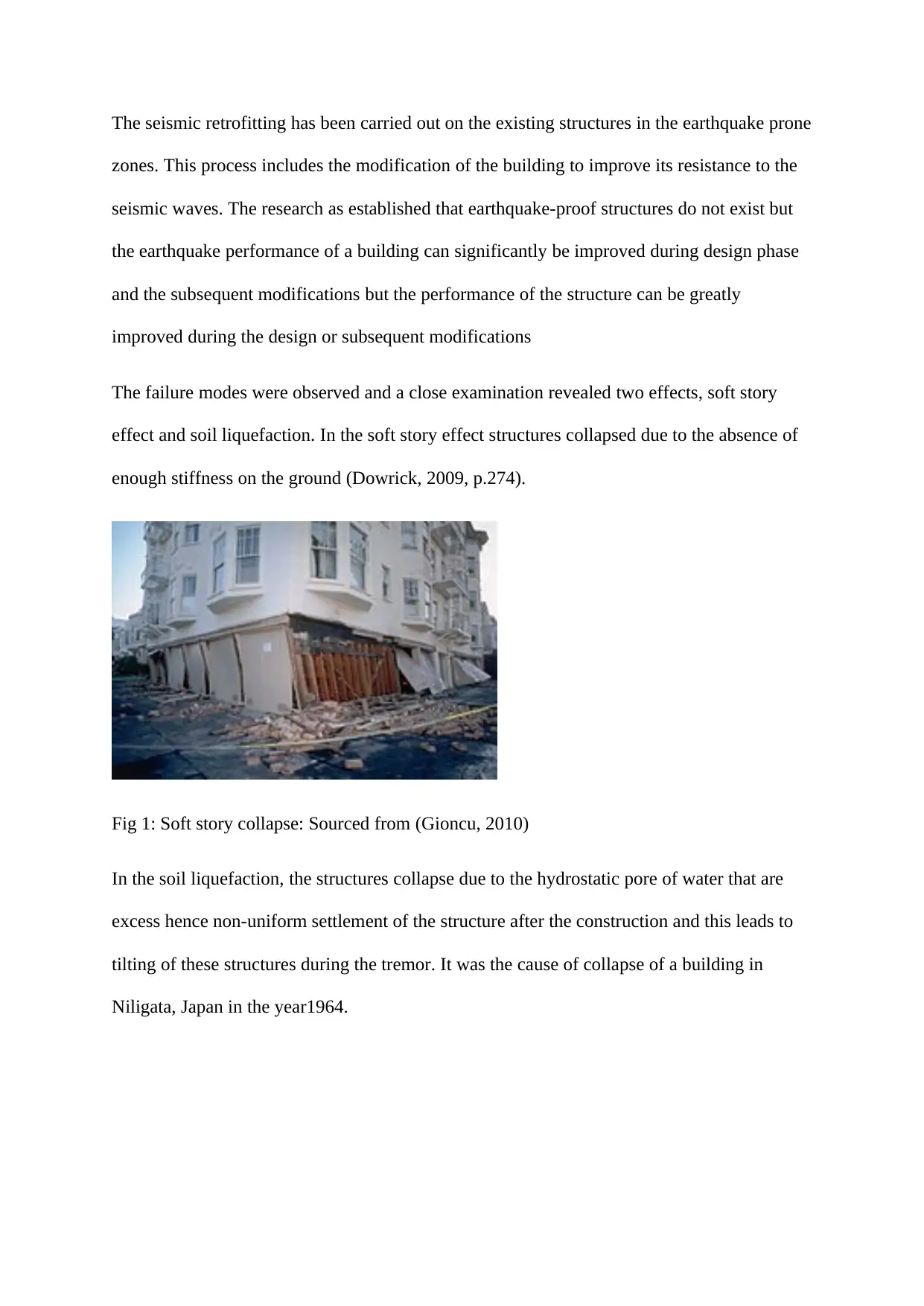
The seismic retrofitting has been carried out on the existing structures in the earthquake prone
zones. This process includes the modification of the building to improve its resistance to the
seismic waves. The research as established that earthquake-proof structures do not exist but
the earthquake performance of a building can significantly be improved during design phase
and the subsequent modifications but the performance of the structure can be greatly
improved during the design or subsequent modifications
The failure modes were observed and a close examination revealed two effects, soft story
effect and soil liquefaction. In the soft story effect structures collapsed due to the absence of
enough stiffness on the ground (Dowrick, 2009, p.274).
Fig 1: Soft story collapse: Sourced from (Gioncu, 2010)
In the soil liquefaction, the structures collapse due to the hydrostatic pore of water that are
excess hence non-uniform settlement of the structure after the construction and this leads to
tilting of these structures during the tremor. It was the cause of collapse of a building in
Niligata, Japan in the year1964.
zones. This process includes the modification of the building to improve its resistance to the
seismic waves. The research as established that earthquake-proof structures do not exist but
the earthquake performance of a building can significantly be improved during design phase
and the subsequent modifications but the performance of the structure can be greatly
improved during the design or subsequent modifications
The failure modes were observed and a close examination revealed two effects, soft story
effect and soil liquefaction. In the soft story effect structures collapsed due to the absence of
enough stiffness on the ground (Dowrick, 2009, p.274).
Fig 1: Soft story collapse: Sourced from (Gioncu, 2010)
In the soil liquefaction, the structures collapse due to the hydrostatic pore of water that are
excess hence non-uniform settlement of the structure after the construction and this leads to
tilting of these structures during the tremor. It was the cause of collapse of a building in
Niligata, Japan in the year1964.
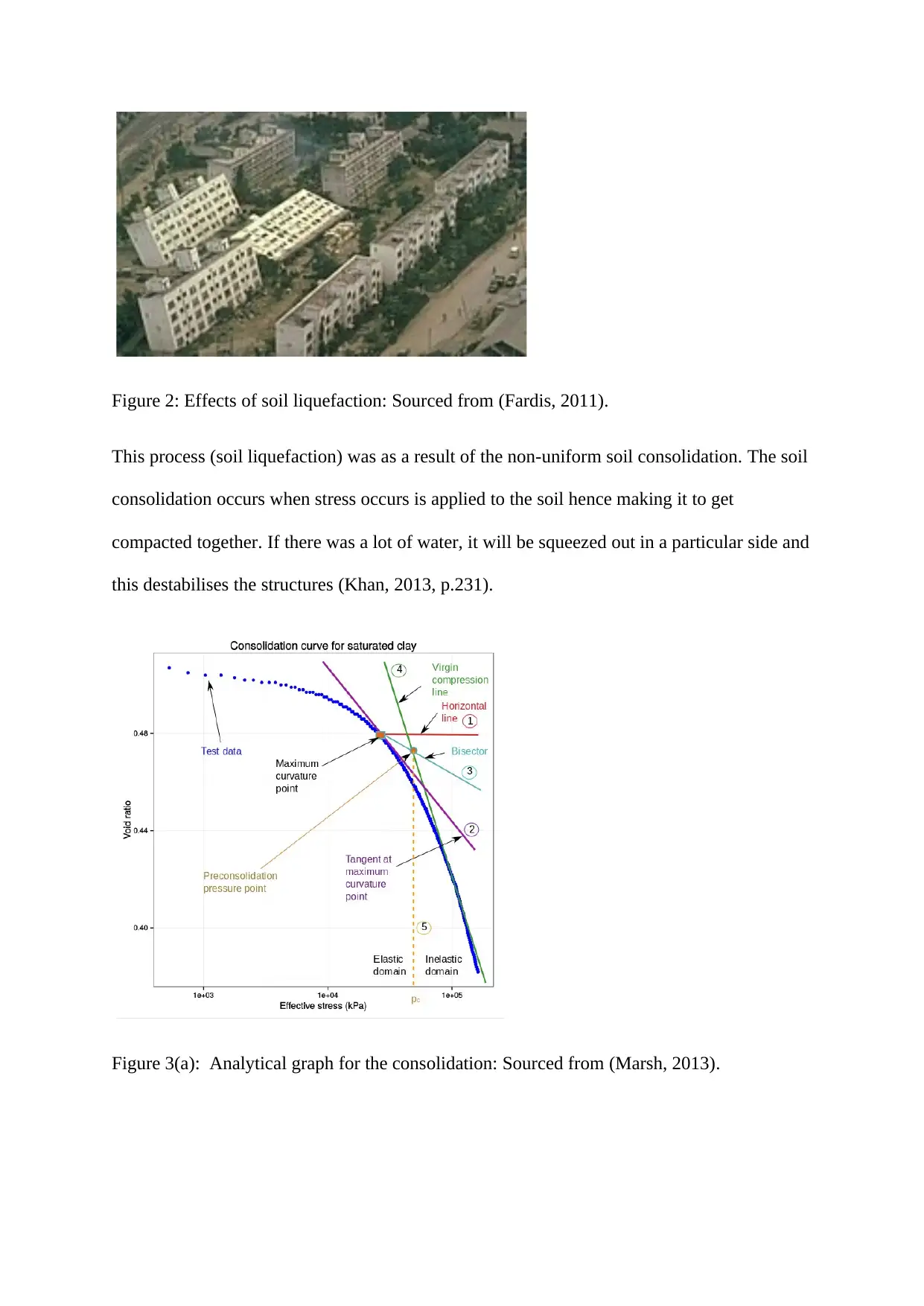
Figure 2: Effects of soil liquefaction: Sourced from (Fardis, 2011).
This process (soil liquefaction) was as a result of the non-uniform soil consolidation. The soil
consolidation occurs when stress occurs is applied to the soil hence making it to get
compacted together. If there was a lot of water, it will be squeezed out in a particular side and
this destabilises the structures (Khan, 2013, p.231).
Figure 3(a): Analytical graph for the consolidation: Sourced from (Marsh, 2013).
This process (soil liquefaction) was as a result of the non-uniform soil consolidation. The soil
consolidation occurs when stress occurs is applied to the soil hence making it to get
compacted together. If there was a lot of water, it will be squeezed out in a particular side and
this destabilises the structures (Khan, 2013, p.231).
Figure 3(a): Analytical graph for the consolidation: Sourced from (Marsh, 2013).
⊘ This is a preview!⊘
Do you want full access?
Subscribe today to unlock all pages.

Trusted by 1+ million students worldwide
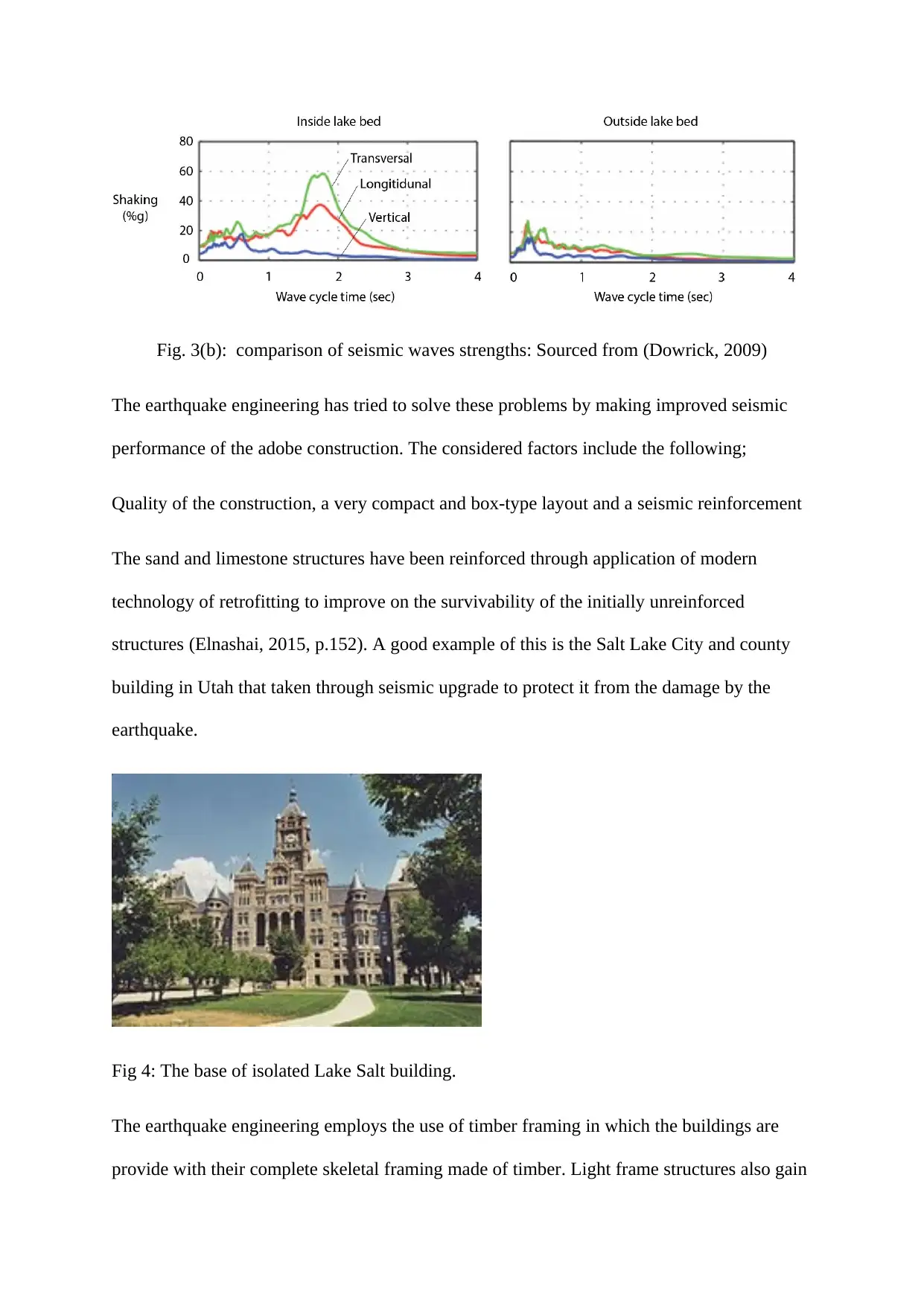
Fig. 3(b): comparison of seismic waves strengths: Sourced from (Dowrick, 2009)
The earthquake engineering has tried to solve these problems by making improved seismic
performance of the adobe construction. The considered factors include the following;
Quality of the construction, a very compact and box-type layout and a seismic reinforcement
The sand and limestone structures have been reinforced through application of modern
technology of retrofitting to improve on the survivability of the initially unreinforced
structures (Elnashai, 2015, p.152). A good example of this is the Salt Lake City and county
building in Utah that taken through seismic upgrade to protect it from the damage by the
earthquake.
Fig 4: The base of isolated Lake Salt building.
The earthquake engineering employs the use of timber framing in which the buildings are
provide with their complete skeletal framing made of timber. Light frame structures also gain
The earthquake engineering has tried to solve these problems by making improved seismic
performance of the adobe construction. The considered factors include the following;
Quality of the construction, a very compact and box-type layout and a seismic reinforcement
The sand and limestone structures have been reinforced through application of modern
technology of retrofitting to improve on the survivability of the initially unreinforced
structures (Elnashai, 2015, p.152). A good example of this is the Salt Lake City and county
building in Utah that taken through seismic upgrade to protect it from the damage by the
earthquake.
Fig 4: The base of isolated Lake Salt building.
The earthquake engineering employs the use of timber framing in which the buildings are
provide with their complete skeletal framing made of timber. Light frame structures also gain
Paraphrase This Document
Need a fresh take? Get an instant paraphrase of this document with our AI Paraphraser
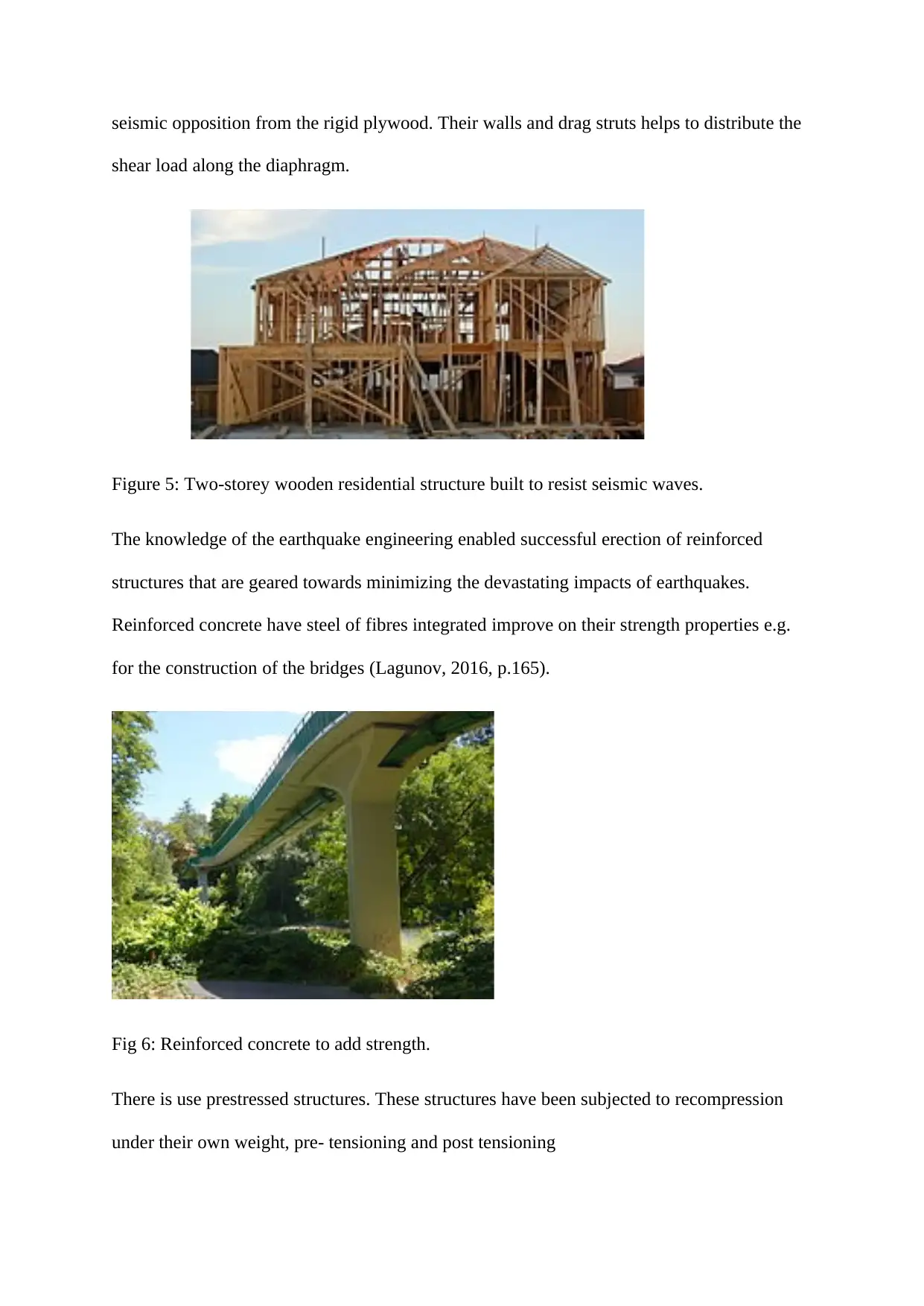
seismic opposition from the rigid plywood. Their walls and drag struts helps to distribute the
shear load along the diaphragm.
Figure 5: Two-storey wooden residential structure built to resist seismic waves.
The knowledge of the earthquake engineering enabled successful erection of reinforced
structures that are geared towards minimizing the devastating impacts of earthquakes.
Reinforced concrete have steel of fibres integrated improve on their strength properties e.g.
for the construction of the bridges (Lagunov, 2016, p.165).
Fig 6: Reinforced concrete to add strength.
There is use prestressed structures. These structures have been subjected to recompression
under their own weight, pre- tensioning and post tensioning
shear load along the diaphragm.
Figure 5: Two-storey wooden residential structure built to resist seismic waves.
The knowledge of the earthquake engineering enabled successful erection of reinforced
structures that are geared towards minimizing the devastating impacts of earthquakes.
Reinforced concrete have steel of fibres integrated improve on their strength properties e.g.
for the construction of the bridges (Lagunov, 2016, p.165).
Fig 6: Reinforced concrete to add strength.
There is use prestressed structures. These structures have been subjected to recompression
under their own weight, pre- tensioning and post tensioning
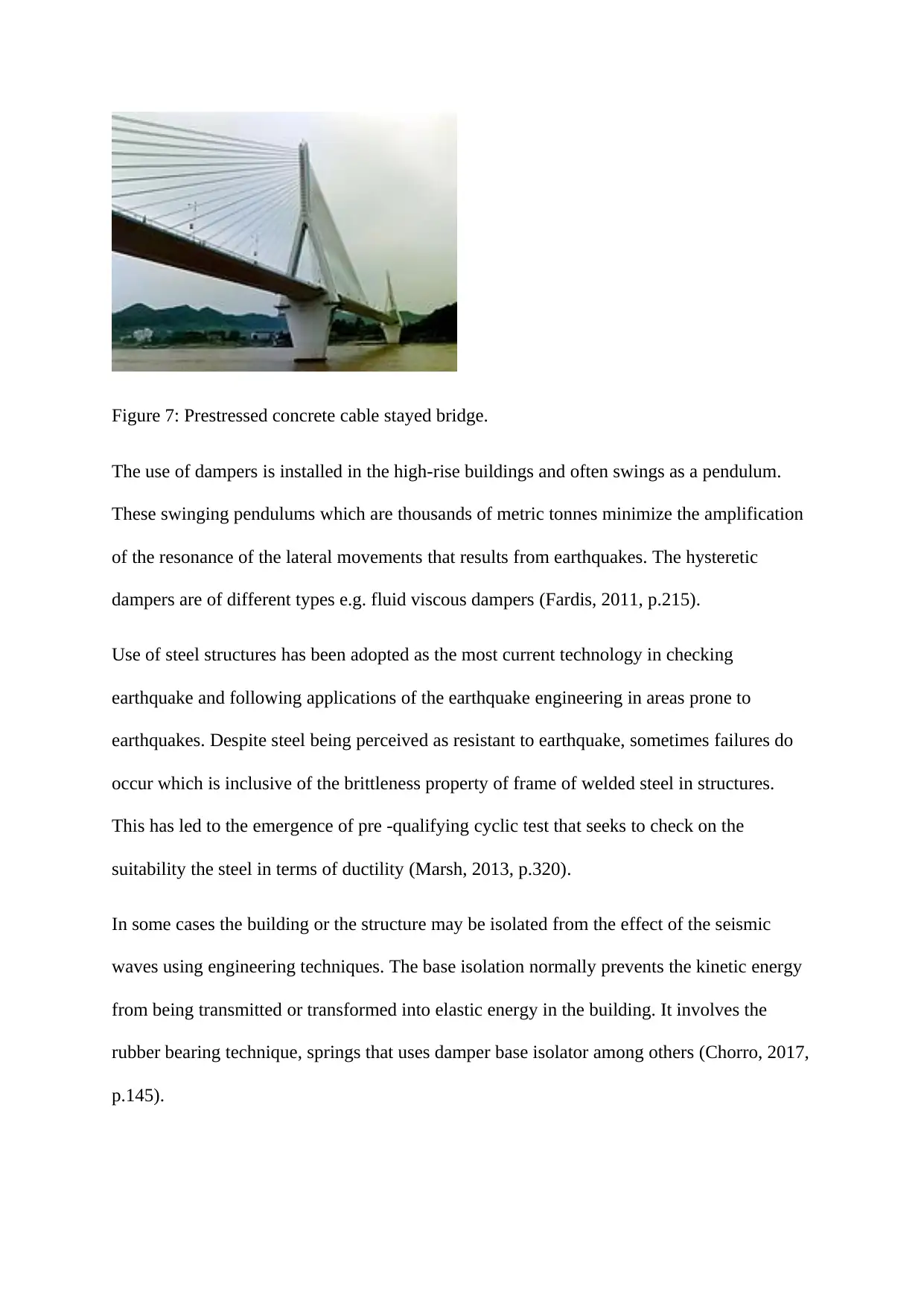
Figure 7: Prestressed concrete cable stayed bridge.
The use of dampers is installed in the high-rise buildings and often swings as a pendulum.
These swinging pendulums which are thousands of metric tonnes minimize the amplification
of the resonance of the lateral movements that results from earthquakes. The hysteretic
dampers are of different types e.g. fluid viscous dampers (Fardis, 2011, p.215).
Use of steel structures has been adopted as the most current technology in checking
earthquake and following applications of the earthquake engineering in areas prone to
earthquakes. Despite steel being perceived as resistant to earthquake, sometimes failures do
occur which is inclusive of the brittleness property of frame of welded steel in structures.
This has led to the emergence of pre -qualifying cyclic test that seeks to check on the
suitability the steel in terms of ductility (Marsh, 2013, p.320).
In some cases the building or the structure may be isolated from the effect of the seismic
waves using engineering techniques. The base isolation normally prevents the kinetic energy
from being transmitted or transformed into elastic energy in the building. It involves the
rubber bearing technique, springs that uses damper base isolator among others (Chorro, 2017,
p.145).
The use of dampers is installed in the high-rise buildings and often swings as a pendulum.
These swinging pendulums which are thousands of metric tonnes minimize the amplification
of the resonance of the lateral movements that results from earthquakes. The hysteretic
dampers are of different types e.g. fluid viscous dampers (Fardis, 2011, p.215).
Use of steel structures has been adopted as the most current technology in checking
earthquake and following applications of the earthquake engineering in areas prone to
earthquakes. Despite steel being perceived as resistant to earthquake, sometimes failures do
occur which is inclusive of the brittleness property of frame of welded steel in structures.
This has led to the emergence of pre -qualifying cyclic test that seeks to check on the
suitability the steel in terms of ductility (Marsh, 2013, p.320).
In some cases the building or the structure may be isolated from the effect of the seismic
waves using engineering techniques. The base isolation normally prevents the kinetic energy
from being transmitted or transformed into elastic energy in the building. It involves the
rubber bearing technique, springs that uses damper base isolator among others (Chorro, 2017,
p.145).
⊘ This is a preview!⊘
Do you want full access?
Subscribe today to unlock all pages.

Trusted by 1+ million students worldwide
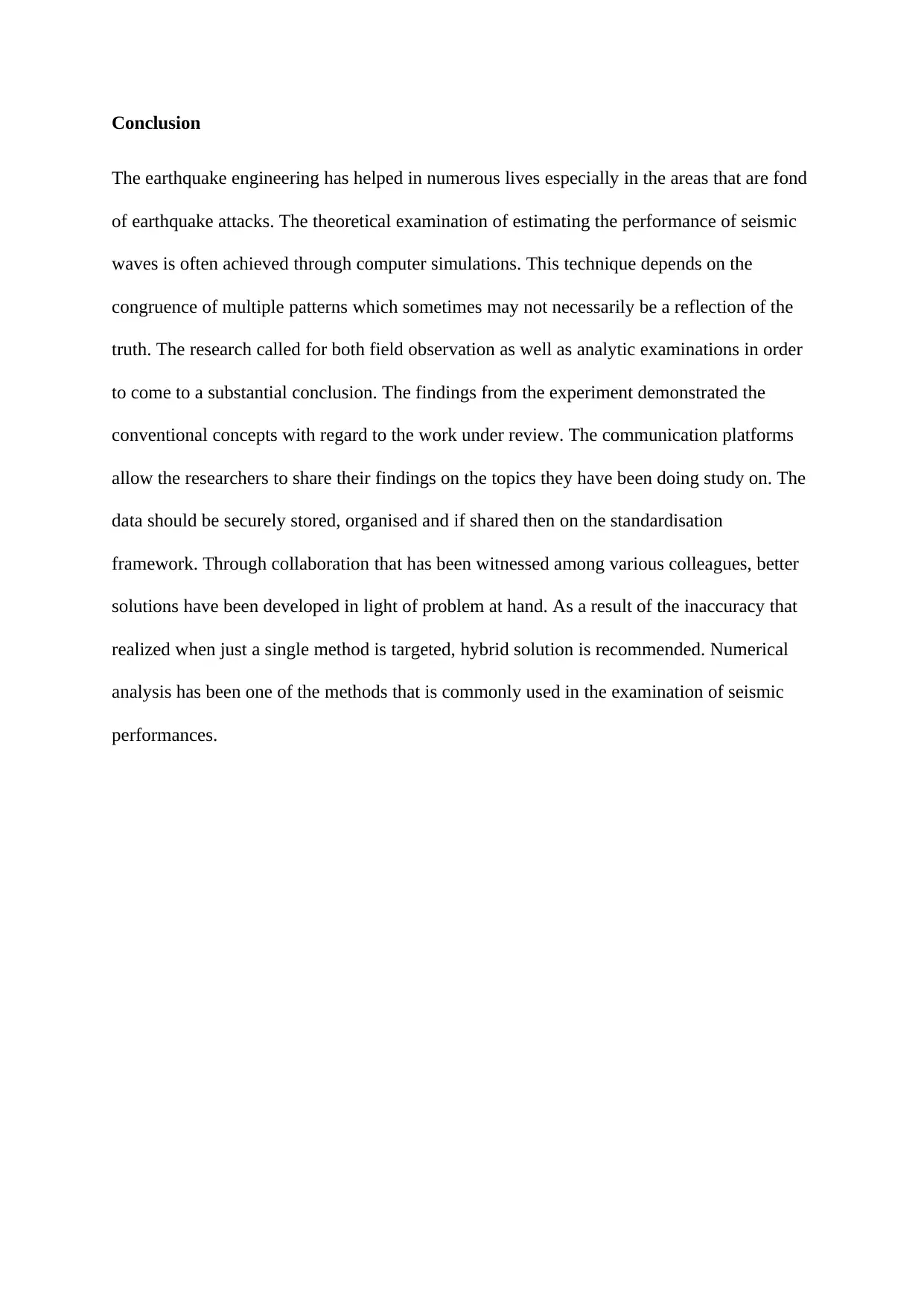
Conclusion
The earthquake engineering has helped in numerous lives especially in the areas that are fond
of earthquake attacks. The theoretical examination of estimating the performance of seismic
waves is often achieved through computer simulations. This technique depends on the
congruence of multiple patterns which sometimes may not necessarily be a reflection of the
truth. The research called for both field observation as well as analytic examinations in order
to come to a substantial conclusion. The findings from the experiment demonstrated the
conventional concepts with regard to the work under review. The communication platforms
allow the researchers to share their findings on the topics they have been doing study on. The
data should be securely stored, organised and if shared then on the standardisation
framework. Through collaboration that has been witnessed among various colleagues, better
solutions have been developed in light of problem at hand. As a result of the inaccuracy that
realized when just a single method is targeted, hybrid solution is recommended. Numerical
analysis has been one of the methods that is commonly used in the examination of seismic
performances.
The earthquake engineering has helped in numerous lives especially in the areas that are fond
of earthquake attacks. The theoretical examination of estimating the performance of seismic
waves is often achieved through computer simulations. This technique depends on the
congruence of multiple patterns which sometimes may not necessarily be a reflection of the
truth. The research called for both field observation as well as analytic examinations in order
to come to a substantial conclusion. The findings from the experiment demonstrated the
conventional concepts with regard to the work under review. The communication platforms
allow the researchers to share their findings on the topics they have been doing study on. The
data should be securely stored, organised and if shared then on the standardisation
framework. Through collaboration that has been witnessed among various colleagues, better
solutions have been developed in light of problem at hand. As a result of the inaccuracy that
realized when just a single method is targeted, hybrid solution is recommended. Numerical
analysis has been one of the methods that is commonly used in the examination of seismic
performances.
Paraphrase This Document
Need a fresh take? Get an instant paraphrase of this document with our AI Paraphraser
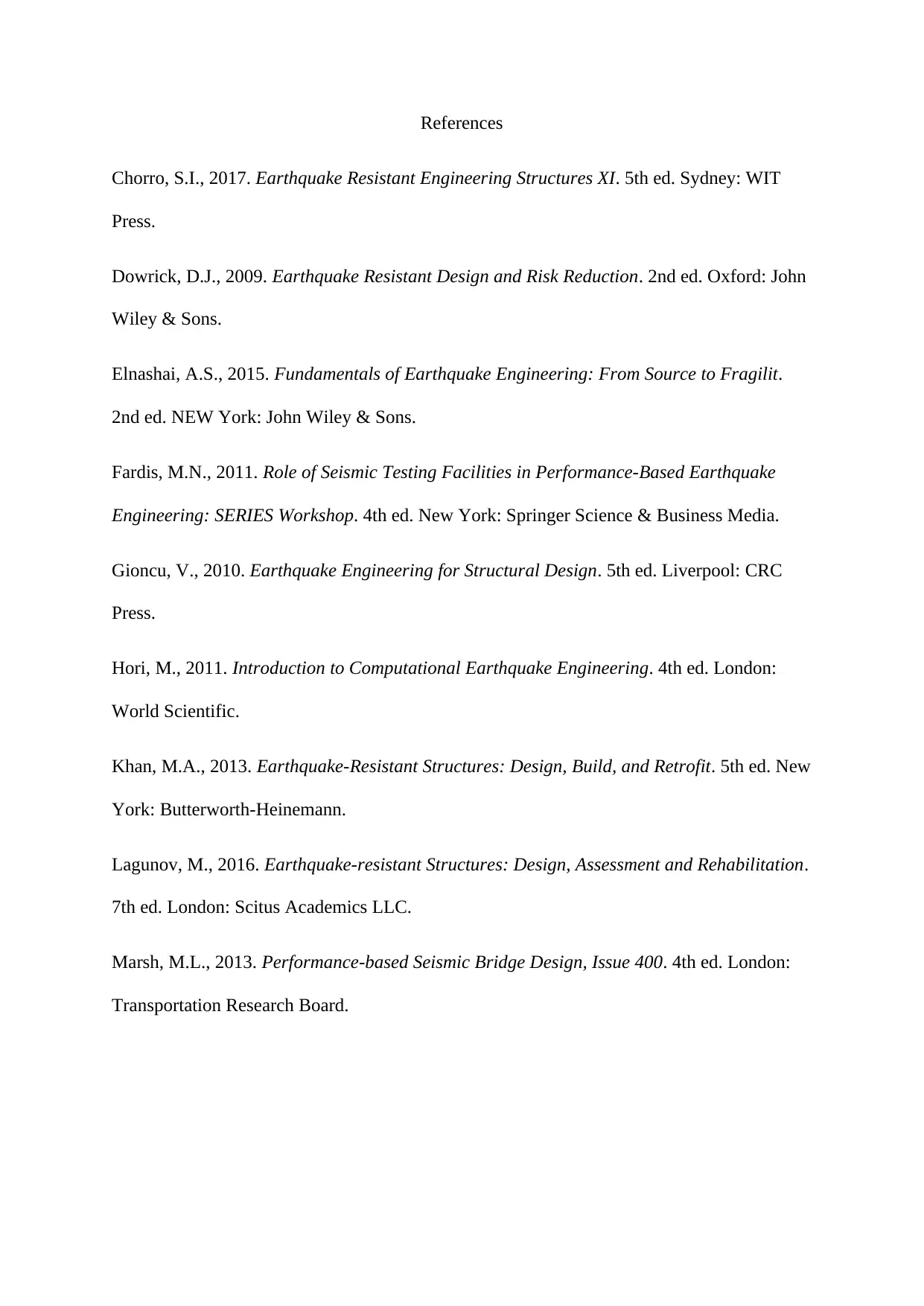
References
Chorro, S.I., 2017. Earthquake Resistant Engineering Structures XI. 5th ed. Sydney: WIT
Press.
Dowrick, D.J., 2009. Earthquake Resistant Design and Risk Reduction. 2nd ed. Oxford: John
Wiley & Sons.
Elnashai, A.S., 2015. Fundamentals of Earthquake Engineering: From Source to Fragilit.
2nd ed. NEW York: John Wiley & Sons.
Fardis, M.N., 2011. Role of Seismic Testing Facilities in Performance-Based Earthquake
Engineering: SERIES Workshop. 4th ed. New York: Springer Science & Business Media.
Gioncu, V., 2010. Earthquake Engineering for Structural Design. 5th ed. Liverpool: CRC
Press.
Hori, M., 2011. Introduction to Computational Earthquake Engineering. 4th ed. London:
World Scientific.
Khan, M.A., 2013. Earthquake-Resistant Structures: Design, Build, and Retrofit. 5th ed. New
York: Butterworth-Heinemann.
Lagunov, M., 2016. Earthquake-resistant Structures: Design, Assessment and Rehabilitation.
7th ed. London: Scitus Academics LLC.
Marsh, M.L., 2013. Performance-based Seismic Bridge Design, Issue 400. 4th ed. London:
Transportation Research Board.
Chorro, S.I., 2017. Earthquake Resistant Engineering Structures XI. 5th ed. Sydney: WIT
Press.
Dowrick, D.J., 2009. Earthquake Resistant Design and Risk Reduction. 2nd ed. Oxford: John
Wiley & Sons.
Elnashai, A.S., 2015. Fundamentals of Earthquake Engineering: From Source to Fragilit.
2nd ed. NEW York: John Wiley & Sons.
Fardis, M.N., 2011. Role of Seismic Testing Facilities in Performance-Based Earthquake
Engineering: SERIES Workshop. 4th ed. New York: Springer Science & Business Media.
Gioncu, V., 2010. Earthquake Engineering for Structural Design. 5th ed. Liverpool: CRC
Press.
Hori, M., 2011. Introduction to Computational Earthquake Engineering. 4th ed. London:
World Scientific.
Khan, M.A., 2013. Earthquake-Resistant Structures: Design, Build, and Retrofit. 5th ed. New
York: Butterworth-Heinemann.
Lagunov, M., 2016. Earthquake-resistant Structures: Design, Assessment and Rehabilitation.
7th ed. London: Scitus Academics LLC.
Marsh, M.L., 2013. Performance-based Seismic Bridge Design, Issue 400. 4th ed. London:
Transportation Research Board.
1 out of 11
Related Documents
Your All-in-One AI-Powered Toolkit for Academic Success.
+13062052269
info@desklib.com
Available 24*7 on WhatsApp / Email
![[object Object]](/_next/static/media/star-bottom.7253800d.svg)
Unlock your academic potential
Copyright © 2020–2025 A2Z Services. All Rights Reserved. Developed and managed by ZUCOL.




